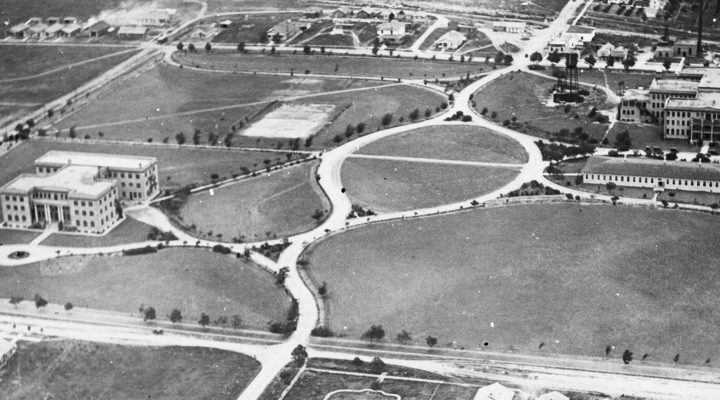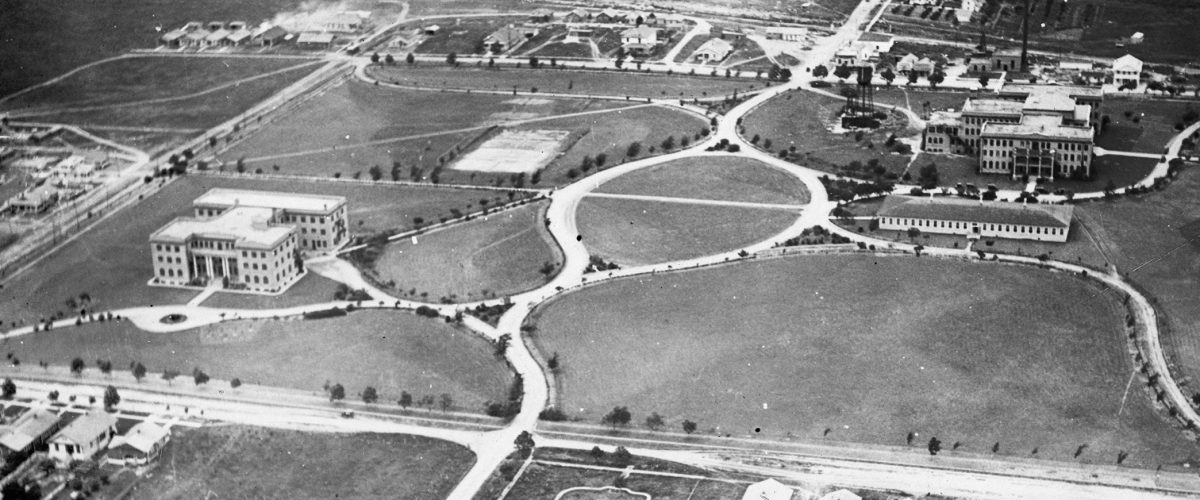Real estate has been at the heart of Southwestern Baptist Theological Seminary’s story from the beginning and now once again could offer a financial lifeline.
Faced with an unspecified but clearly significant financial problem, the Fort Worth, Texas, seminary has listed a 24-acre parcel for sale and is likely to sell off other real estate, according to recent statements by Interim President David Dockery.
The 24-acre tract now occupied by Carroll Park student housing could fetch as much as $15 million, according to commercial real estate consultants who reviewed the offering on behalf of BNG. That would be a sizable one-time gain for a school with an annual budget of $37 million.
Last week, Southwestern administrators confirmed staff layoffs are under way as part of a 10% budget reduction. The school reportedly faces a multi-million dollar budget shortfall this year due to declining enrollment and years of overspending.
From the beginning
Real estate played a pivotal role in attracting Southwestern Seminary to Fort Worth in the first place. The seminary began in 1908 in Waco, home of Baylor University. Founding President B.H. Carroll feared if the seminary remained in Waco either it would grow to overshadow Baylor or Baylor would grow to overshadow the seminary.
Thus, a call was put out statewide for relocation offers. Proposals came in not only from Fort Worth and Dallas (already the headquarters of the state Baptist convention) but from smaller towns around North Central Texas. The offer from Fort Worth won the day, however, because of $100,000 in cash raised for the seminary (the equivalent of $3 million today) and an array of real estate.
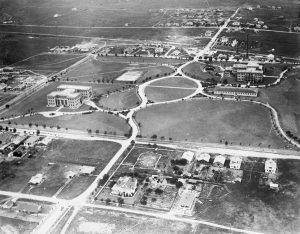
Aerial view of Southwestern Baptist Theological Seminary, Fort Worth, Texas. (1920). On the top right is Fort Worth Hall, the original building on campus. Fort Worth Star-Telegram Collection, University of Texas at Arlington Libraries.
Robert Baker describes this generous offer in his history of Southwestern titled Tell the Generations Following. Wealthy civic leaders (mostly Baptists) in Fort Worth offered tracts of land that would combine to create Seminary Hill. That included 30 acres from J.K. Winston, 10 acres from H.C. McCart, 20 acres from W.D. Reynolds, 10 acres from Matt Blanton, 20 acres from the heirs of J.T. Wright, 30 acres from the S.J. Jennings survey, and 14 acres from G.E. Tandy. Those 134 acres also came with partial interest and options on additional land.
On this donated land, the seminary erected its first permanent home, Fort Worth Hall. That building still stands on campus today and has been a men’s dormitory for several decades.
In those days, Seminary Hill fell several miles outside the Fort Worth city limits and was not served by the interurban that was a vital transportation hub for the city of 75,000 people. Early faculty and staff built homes all around the seminary in order to have somewhere to live but there were no grocery stores or any stores at all.
From the beginning, Seminary Hill was viewed as a special place, a sentiment expressed just last week by O.S. Hawkins, who is serving in the interim role of special advisor at Southwestern. In a series of tweets about the seminary’s situation, he said: “This hill in South Fort Worth has a history of being a miracle place since the first time B.H. Carroll viewed it in a Model T Ford a century ago. We (are) looking up for a miracle from God as we seek to rebuild these walls for future generations.”
Acquisitions and dispositions
Over time, the city grew southward toward Seminary Hill and beyond. Subdivisions and retail and industry filled in as Cowtown became a major population center and business hub. The east-west major thoroughfare that runs across the front of the campus was named Seminary Drive, and in 1962 Fort Worth’s first enclosed mall was built just down the road and named Seminary South Center.
For the most part, the neighborhoods closest to the seminary featured modest homes built from the 1920s through the 1950s. The seminary’s grand buildings — which came to include the iconic domed administration building and other signature structures — have long stood in contrast to the adjoining neighborhoods. Some of the largest houses in the area ring the main campus and today are the seminary-owned homes of vice presidents and top-level administrators.
Over the last century, Southwestern Seminary has acquired additional real estate and sold off other properties. One of the most notable developments is that several blocks of single-family residences built adjacent to the campus in the early 20th century have been razed and now stand as empty lots. The seminary also owns other single-family residences that are either occupied by students or rented out on the open market.
Recent additions
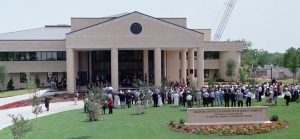
Dedication of the Riley Center, which originally was named the Ralph M. Smith Leadership Development Center.
Four major structures have been placed on some of this vacant land in recent years, beginning with the Riley Center, a hotel and special events center that includes 55 guest rooms and multiple conference/banquet spaces that can accommodate up to 3,500 people. The first phase of this complex opened in 2000.
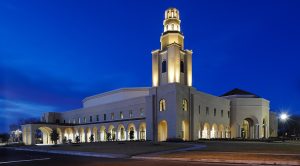
MacGorman Chapel
Another major addition came in 2011 with the J.W. MacGorman Chapel and Performing Arts Center, which was hailed as the largest venue of its kind in Fort Worth. The chapel seats 3,500 people and is the equivalent of a megachurch worship space.

Horner House
Third is the Horner House, a two-story home originally built to house a homemaking program for seminary wives during the administration of President Paige Patterson. When former President Adam Greenway took over, he revamped that program, which had been widely ridiculed as sexist, and changed the massive home to a hospitality center.

The building intended to be a retirement home for Paige and Dorothy Patterson and a historical colleciton.
Fourth is a huge structure built in 2018 that is billed today as a Baptist Heritage Center but actually was intended as the retirement home of Paige Patterson and his wife, Dorothy, before trustees later rescinded that decision when Patterson was fired.
All four of these new structures are situated on the southern edge of the main campus and abut a sea of empty residential lots.
Other new buildings on campus include the nearby Mathena Hall, completed in 2017, and home to the Roy Fish School of Evangelism and Texas Baptist College, Southwestern’s undergraduate school; and Student Village Apartments, built in 2013 to replace aging apartments that were torn down.
More land than students
Given the declining enrollment at Southwestern over the past 30 years, the seminary now finds itself with more land and more buildings than it needs. Parking lots sit empty, some classrooms and student housing are vacant.
Rebuilding enrollment to the levels of the glory days would demand fuller use of all the existing space, but returning to the enrollment levels of the 1990s seems unlikely — given overall trends in theological education and the rising popularity of online learning.
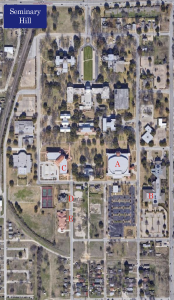
Aerial view of Southwestern Seminary campus today, via Google Maps. Building A is the MacGorman Chapel complex. Building B is the Riley Center complex. Building C is Mathena Hall. Building D is Horner House. Building E is the structure built as a retirement home for Paige and Dorothy Patterson.
For now, one of the most obvious albatrosses around the seminary’s financial neck is the 3,500-seat chapel that not only is three times bigger than the student body but requires enormous resources to keep running.
Fort Worth already has world-class performance venues in its downtown Sundance Square district, including Bass Performance Hall, so it is unlikely that major arts events would shift six miles south to Seminary Hill. Texas Christian University, located just a few miles from the seminary, recently built a new home for its music school that includes brand-new performance halls.
Some have speculated that a church could take over MacGorman Chapel, but that also seems unlikely, given that all the largest churches in town have existing facilities and, like churches across the world, are struggling to refill them with the same numbers of worshipers as before COVID.
Thus, it is the vacant land and the remote Carroll Park housing complex that make the most sense to be carved off from the main campus in order to generate income.
Gentrification and economic development
And that prospect creates an usual opportunity not only for the seminary but for the city. Gentrification has been moving ever closer to Seminary Hill, emanating from the edges of the TCU campus toward the south and east. Already, streets lined with 1930s homes are giving way to new construction interspersed among the older — and much smaller — houses.
But for now, that gentrification comes to an abrupt halt at the railroad tracks. Coming from the north and west, Seminary Hill falls on “the other side of the tracks,” as the old saying goes. Even Carroll Park, which is situated a mile away from the main campus, lies on the other side of the tracks and adjacent to industrial businesses.
The commercial real estate firm marketing Carroll Park is billing it as an opportunity for a major developer to become a pacesetter in rebuilding the south side of Fort Worth. And indeed, adding more than 500 units of housing on that 24-acre plot as the sales brochure suggest would radically transform the sleepy neighborhood that looks like time has forgotten.
According to data from the 2020 U.S. Census, the neighborhood around Carroll Park is more than 70% Hispanic. More people speak Spanish as their primary language than English. The median rent in the ZIP Code is $1,025 per month. Fifty-five percent of existing housing was built before 1949, with nearly 40% built before 1939. The median household income is $56,389.
The sales flyer from the real estate firm, in its example of economic opportunity for the site, projects a monthly rent of $1,765 for the new units that would be built there. That could be good for the city and its tax base, as well as its overall economic development. But it could be bad for the current residents of the neighborhood who likely would get priced out of their own homes.
The City of Fort Worth has an economic development plan that targets part of south Fort Worth for growth and offers special tax breaks for developers, but the area around Carroll Park is not included in those incentives. BNG sought comment on the city’s development plans from both the economic development office and from City Council member Elizabeth Beck, as well as the broker listing the property, and none of them responded.
Rebuilding the seminary
Meanwhile, the metaphor Hawkins has adopted to explain the work he and Dockery and the trustees hope to do is drawn from the biblical account of Nehemiah, who rebuilt Jerusalem after it had been ransacked.
“As we continue in the rebuilding process, we are following the biblical pattern set forth by Nehemiah as he set out to rally the people to rebuild the broken walls and burned gates of Jerusalem,” Hawkins said in his recent series of tweets. “We are facing up, teaming up-girding up and looking up.
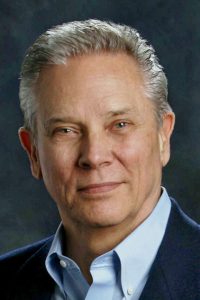
O.S. Hawkins
“We are facing up to the reality of where we are and how we got here. The hard truth is that for month after month Southwestern has faced massive budget deficits each month. The trustees have demanded a detailed accounting of all expenditures, bidding processes, etc., and it is forthcoming.
“We are teaming up. Morale on campus is high and there are many promising signs on the horizon including reports of hopeful enrollment increases coming. Our SBC family is getting on the team as we hear from more and more with prayer and financial support daily.
“We are girding up. We are working hard to correct what our chairman referred to as ‘dysfunctions’ — budget mismanagement — overspending. Correcting years of financial mismanagement demands some hard decisions, and these are days when we need your prayers more than ever.”
The rebuilding image harkens back to the founding of the Fort Worth campus in 1910, when it was only by the generosity of donors that land was acquired and buildings erected. And even then, the location was isolated and had no city utilities. Those were difficult days, indeed, as Baker describes in his history.
Baker’s description of that first year in Fort Worth might fit Hawkins’ image of Nehemiah too: “Like a plane catapulted from the deck of an aircraft carrier, the seminary at first seemed to hesitate precariously after departing its old home but soon found the surge of power that began to lift it up and away from the threat of catastrophic crash.”
Related articles:
Layoffs begin at Southwestern Seminary
Southwestern trustee chairman addresses president’s departure; seminary may sell more land
Southwestern Seminary lists 24-acre parcel for sale
What happened at Southwestern and why does it matter? | Analysis by Mark Wingfield

